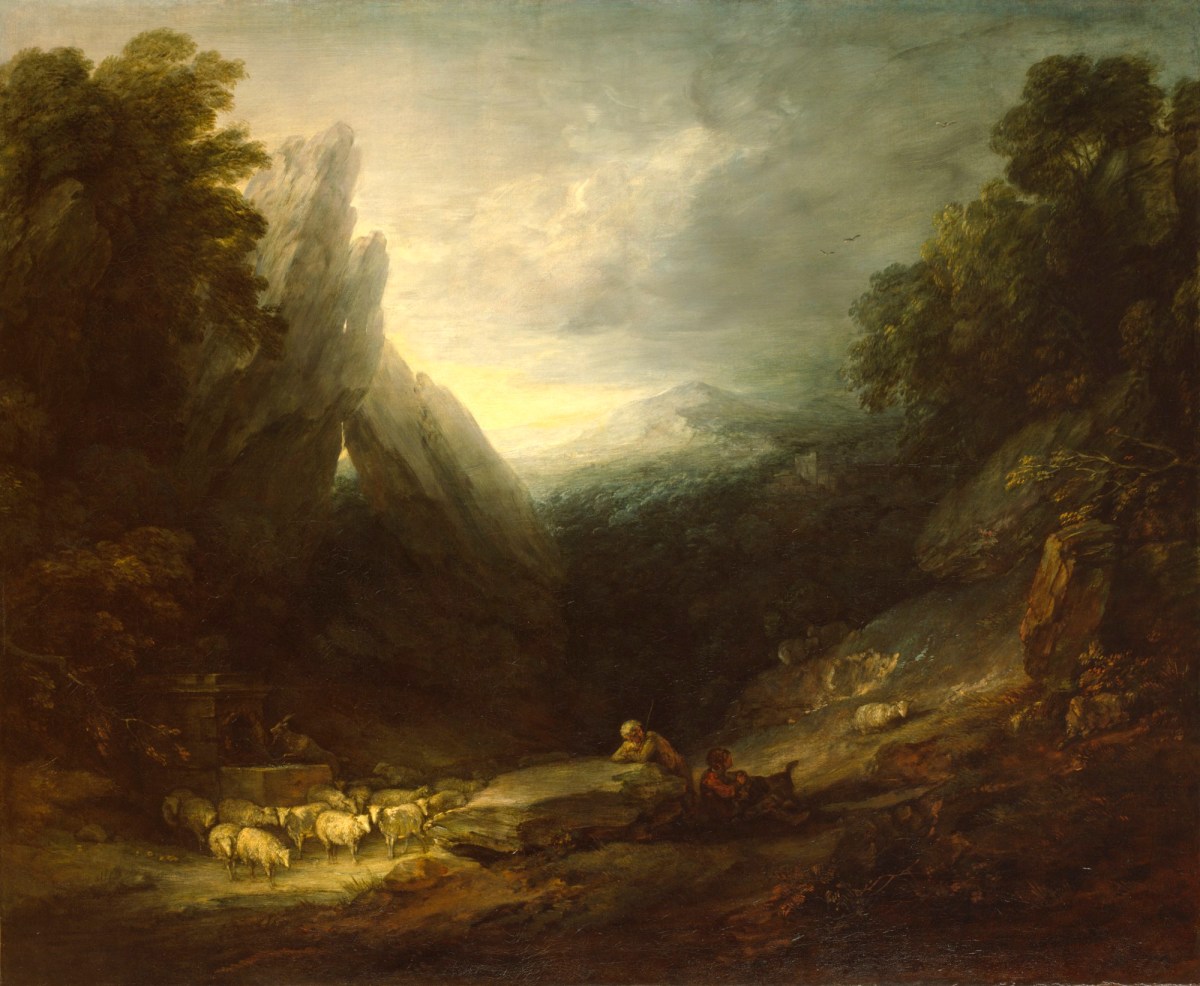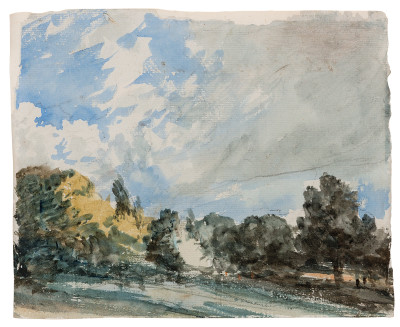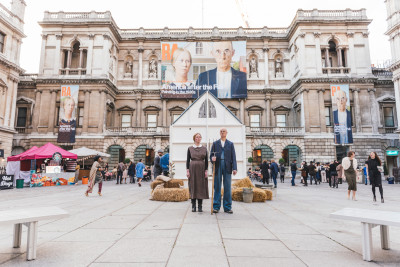
Thomas Gainsborough RA, Romantic Landscape with Sheep at a Spring, ca. 1783.
Oil on canvas. 1537 mm x 1867 mm. © Photo: Royal Academy of Arts, London. Photographer: Prudence Cuming Associates Limited.
This image is not available to download. To licence this image for commercial purposes, contact our Picture Library at picturelibrary@royalacademy.org.uk
Romantic Landscape with Sheep at a Spring, ca. 1783
Thomas Gainsborough RA (1727 - 1788)
RA Collection: Art
This picture is more dramatic, and larger, than Gainsborough’s earlier landscape paintings and may have been inspired by scenes he saw when he visited the West Country in 1782 and the Lake District in 1783. However, he in fact painted many of his landscapes in his studio from models made of things like cork, moss and broccoli. The large rocks here do look rather like pieces of coal.
In the centre, two shepherds are lost in thought while, to the left, the towering rocks loom over a bucolic scene of sheep grazing and a goat drinking from a spring. The sheep are spotlit in a way that implies the sun is to the left, but in the background it seems to be rising or setting near the distant mountain. Susan Sloman observes that there is a 'bowl-like hollow' in the centre of the painting 'that shelters the figures and animals and, at the same time, isolates them from the outside world'. She believes that the picture has 'a primordial atmosphere' as well as 'some charming detail', such as the goat climbing on the well spring - 'moments of levity in an otherwise heavyweight picture'. She also speculates on whether the painting has Christian symbolism. (Sloman 2011, p. 95 and pp. 96-7)
19th-century opinions
The Victorian writer and artist John Ruskin had mixed views about ‘Romantic Landscape’. He started positively:
'Nothing can be more attractively luminous or aerial than the distance of the Gainsborough, nothing more bold or inventive than the forms of its crags and the diffusion of the broad distant light upon them, where a vulgar artist would have thrown them into dark contrast.’
However, he went on to criticise the picture’s lack of naturalism, perhaps caused in part by Gainsborough’s use of a model including broccoli and coal:
‘But it will be found that the light of the distance is brought out by a violent exaggeration of the gloom in the valley; that the forms of the green trees which bear the chief light are careless and ineffective; that the markings of the crags are equally hasty; and that no object in the foreground has realisation enough to enable the eye to rest upon it.'
(The Works of John Ruskin, edited by E. T. Cook and Alexander Wedderburn, London, 1903-12. vol. 3, p. 190.)
John Constable RA didn’t write about this work in particular, but in a lecture in 1836 he paid tribute to Gainsborough’s landscapes in general, finding them ‘soothing, tender, and affecting. The stillness of noon, the depths of twilight, and the dews and pearls of the morning are all to be found in the canvases… On looking at them, we have tears in our eyes, and know not what brings them’.
Recent commentary
Martin Myrone notes that 'Romantic Landscape' and Gainsborough's other later landscapes are often regarded as precursors of Romanticism, seen as being produced by 'an artist alienated from modern life who sought in ideal landscapes an emotional release from the labours of portraiture.' However, they are just as much 'challenging artistic statements, a sensuous reinvigoration of the formal traditions of the Grand Style.' (Myrone 2002, p. 248) The landscape is essentially ideal and generalised rather than naturalistic and particular.
Several authors note that this painting is one of several of the period that mark Gainsborough's move away from earlier more pastoral landscapes and draw attention to the contrast of the gentle, bucolic scene of animals and figures with the sublime rocks and distant mountain. Hayes describes the picture as 'rugged, grand and, indeed, solemn in character... sublime'. (Hayes 1982, p. 131) Myrone writes 'The figure of a sleeping shepherd as a type is familiar from the artist's very earliest works, but is cast here into a monumental and fantastical landscape, first and foremost an artful contrivance clearly referring to Dughet and Claude in its style and motifs.' (Myrone 2002, p. 248)
A gift from Gainsborough’s daughter
Thomas Gainsborough's younger daughter Margaret presented the painting to the Royal Academy in 1799. As thanks for the gift of the painting, the Academy presented her with a silver cup, designed by Benjamin West PRA. The Council Minutes record that on 2 February 1799 it was 'resolved that a cup, value fifty pounds, with a suitable inscription engraved thereon, be prepared, and presented to Miss Gainsborough, as a mark of the high respect they have for the memory of her father, and so valuable a picture, she has presented to the Royal Academy'. The cup is now in the RA collection 03/5956 and 03/5957.
Some writers have claimed ‘Romantic Landscape’ was intended to serve as Gainsborough’s Diploma Work but, as a founder member of the Academy, he was not required to give a Diploma Work. His daughter may have given the painting because before he died in 1788 he did not fulfil a promise to paint a work for the chimney breast in the Council Room at Somerset House (RA Council Minutes, 13 September 1787). 'Romantic Landscape' is close in width to the chimneypiece. (The room was also known as the Assembly Room, the Lecture Room and the Second Room of the Antique Academy.)
Dating
The painting is usually dated c1783, but Susan Sloman observes, 'It is difficult to say exactly when the Romantic Landscape was painted, and it may have been in production over a long period.' She dates the picture to 1780-85. (Sloman 2011, pp. 89, 93)
Related works
Mountainous Wooded Landscape with Figures and Sheep (Study for 'Romantic Landscape'), black and white chalk with black ink on faded blue laid paper, RA Collection 12/930, formerly in the collection of Arnold Haskell. (Hayes, Drawings, no. 602. Hayes, Landscapes, Vol. II, Repr.138a, p. 504)
A Mountain Landscape with Figures and Sheep by a Fountain, 1785-88, Grey wash, oil and black chalk, Yale Centre for British Art, B1977.14.6175, http://collections.britishart.yale.edu/vufind/Record/1671770
Study/Unfinished smaller version, oil on canvas, on the London art market 2017, from an 'American Collection' where it had been since at least the 1920s
Further Reading
John Hayes, The Drawings of Thomas Gainsborough, R.A., London and New Haven: Yale University Press, 1970, pp. 248, 275
John Hayes, The Landscape Paintings of Thomas Gainsborough, London: Sotheby Publications, 1982, vol. II, no. 138, pp. 504-505
Martin Myrone, cat entry in Gainsborough, Exh Cat, Tate Britain, 2002, p. 248
Susan Sloman, Gainsborough's Landscapes: Themes and Variations, Exh Cat, Holburne Museum and Compton Verney, 2011-2012, pp. 89-97
Supported by Harry Hyman and family
Object details
1537 mm x 1867 mm
Associated works of art
2 results
Start exploring the RA Collection
- Explore art works, paint-smeared palettes, scribbled letters and more...
- Artists and architects have run the RA for 250 years.
Our Collection is a record of them.





